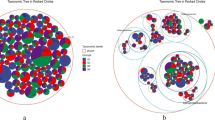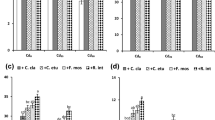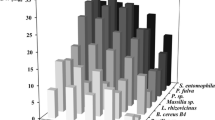Abstract
Pot culture experiments were conducted in a glasshouse to evaluate the effects of four efficient Cr(VI)-reducing bacterial strains (SUCR44, SUCR140, SUCR186, and SUCR188) isolated from rhizospheric soil, and four arbuscular mycorrhizal fungi (AMF—Glomus mosseae, G. aggregatum, G. fasciculatum, and G. intraradices) alone or in combination, on Zea mays in artificially Cr(VI)-amended soil. Presence of a strain of Microbacterium sp. SUCR140 reduced the chromate toxicity resulting in improved growth and yields of plants compared to control. The bioavailability of Cr(VI) in soil and its uptake by the plant reduced significantly in SUCR140-treated plants; the effects of AMF, however, either alone or in presence of SUCR140 were not significant. On the other hand, presence of AMF significantly restricted the transport of chromium from root to the aerial parts of plants. The populations of AMF chlamydospores in soil and its root colonization improved in presence of SUCR140. This study demonstrates the usefulness of an efficient Cr(VI)-reducing bacterial strain SUCR140 in improving yields probably through reducing toxicity to plants by lowering bioavailability and uptake of Cr(VI) and improving nutrient availability through increased mycorrhizal colonization which also restricted the transport of chromium to the aerial parts.






Similar content being viewed by others
References
Ackerley DF, Barak Y, Lynch SV, Curtin J, Matin A (2006) Effect of chromate stress on Escherichia coli K-12. J Bacteriol 188:3371–3381
Asmatullah Qureshi SN, Shakoori AR (1998) Hexavalent chromium induced congenital abnormalities in chick embryos. J Appl Toxicol 18(3):167–171
Bagchi D, Stohs SJ, Downs BW, Bagchi M, Preuss HG (2002) Cytotoxicity and oxidative mechanism of different forms of chromium. Toxicology 180:5–22
Burd GI, Dixon DG, Glick BR (2000) Plant growth promoting bacteria that decreases heavy metal toxicity in plants. Can J Microbiol 46:237–245
Castro RO, Trujillo MM, Bucio JL, Cervantes C, Dubrovsky J (2007) Effects of dichromate on growth and root system architecture of Arabidopsis thaliana seedlings. Plant Sci 172:684–691
Cervantes C, Campos-Garcia J, Gutierrez-Corona F, Loza-Tavera H, Torres-Guzman JC, Moreno-Sanchez R (2001) Interactions of chromium with microorganisms and plants. FEMS Microbiol Rev 25:335–347
Chen B, Christie P, Li X (2001) A modified glass bead compartment cultivation system for studies on nutrient and trace metal uptake by arbuscular mycorrhiza. Chemosphere 42:158–192
Chen BD, Li XL, Tao HQ, Christie P, Wong MH (2003) The role of arbuscular mycorrhiza in zinc uptake by red clover growing in a calcareous soil spiked with various quantities of zinc. Chemosphere 50:839–846
Cheung KH, Gu JD (2007) Mechanism of hexavalent chromium detoxification by microorganisms and bioremediation application potential: a review. Int Biodeterior Biodegrad 59:8–15
Chidambaram A, Sundaramoorthy P, Murugan A, Sankar Ganesh K, Baskaran L (2009) Chromium induced cytotoxicity in blackgram (Vigna mungo L.). Iran J Environ Health Sci Eng 6:17–22
Citterio S, Prato N, Fumagalli P, Aina R, Massa N, Santagostinoa A, Sgorbati S, Berta G (2005) The arbuscular mycorrhizal fungus Glomus mosseae induces growth and metal accumulation changes in Cannabis sativa L. Chemosphere 59:21–29
Codd R, Irwin JA, Lay PA (2003) Sialoglycoprotein and carbohydrate complexes in chromium toxicity. Curr Opi Chem Biol 17(2):213–219
Davies FT Jr, Puryear JD, Newton RJ, Egilla JN, Grossi JAS (2001) Mycorrhizal fungi enhance accumulation and tolerance of chromium in sunflower (Helianthus annuus). J Plant Physiol 158:777–786
Dixit V, Pandey V, Shyam R (2002) Chromium ions inactivate electron transport and enhance superoxide generation in vivo in pea (Pisum sativum L.cv. Azad) root mitochondria. Plant Cell Environ 25:687–690
Gerdemann JW, Nicolson TH (1963) Spores of mycorrhizal Endogone species extracted from soil by wet sieving and decanting. Trans Brit Mycol Soc 46:235–246
Gheju M, Balcu I, Ciopec M (2009) Analysis of hexavalent chromium uptake by plants in polluted soils. Ovidius Univ Ann Chem 20:12–131
Ghosh M, Singh SPA (2005) A comparative study of cadmium phytoextraction by accumulator and weed species. Environ Pollut 133:365–371
Glick BR, Patten CL, Holguin G, Penrose GM (1999) Biochemical and genetic mechanisms used by plant growth promoting bacteria. Imperial College Press, London
Gother V, Paszkowski U (2006) Contribution of the arbuscular mycorrhizal symbiosis to heavy metal phytoremediation. Planta 223:1115–1122
Hayat S, Gulshan Khalique G, Irfan M, Wani AS, Tripathi BN, Ahmad A (2012) Physiological changes induced by chromium stress in plants: an overview. Protoplasma. doi:10.1007/s00709-011-0331-0
Kalra A, Chandra M, Awasthi A, Singh AK, Khanuja SPS (2010) Natural compound enhancing growth and survival of rhizobial inoculants in vermicompost based formulation. Biol Fertil Soil 46:521–524
Kanga SY, Lee JU, Kim KW (2007) Biosorption of Cr(III) and Cr(VI) onto the cell surface of Pseudomonas aeruginosa. Biochem Engin J 36:54–58
Karagiannidis N, Hadjisavva Zinoviadi S (1998) The mycorrhizal fungus Glomus mosseae enhances growth, yield and chemical composition of a durum wheat variety in 10 different soils. Nutr Cycl Agroecos 52:1–7
Khan AG (2001) Relationship between chromium biomagnification accumulation factor, and mycorrhizae in plants growing on tannery effluent-polluted soil. Environ Int 26:417–423
Krishna RK, Philip L (2005) Bioremediation of Cr(VI) in contaminated soils. J Hazard Mater 121:109–117
Liu DH, Jaing WS, Li MX (1993) Effect of chromium on root growth and cell division of Allium cepa. Isr J Plant Sci 42:235–243
Losi ME, Frankenberger WT (1994) Chromium-resistant microorganisms isolated from evaporation ponds of a metal processing plant. Water Air Soil Pollut 74:405–413
Mabbett AN, Lloyd JR, Macaskie LE (2002) Effect of complexing agents on reduction of Cr(VI) by Desulfovibrio vulgaris ATCC29579. Biotechnol Bioeng 79(4):389–397
Mandiwana KL, Panichev N, Kataeva M, Siebert S (2007) The solubility of Cr(III) and Cr(VI) compounds in soil and their availability to plants. J Hazard Mat 147:540–545
McGonigle TP, Miller MH, Evans DG, Fairchild GL, Swan JA (1990) A new method which gives an objective measure of colonization of roots by vesicular–arbuscular mycorrhizal fungi. New Phytol 11:495–501
Mishra S, Singh V, Srivastava S, Srivastava R, Srivastava MM, Dass S, Satsangi GP, Prakash S (1995) Studies on uptake of trivalent and hexavalent chromium by maize (Zea mays). Food Chem Toxicol 33:393–397
Mohanty M, Patra HK (2011) Attenuation of chromium toxicity by bioremediation technology. Env Contam Toxicol 210:1–34
Moya JL, Ros R, Picazo I (1995) Heavy-metal hormone interactions in rice plants: effects on growth, net photosynthesis, and carbohydrate distribution. J Plan Gro Regulat 14:61–67
Pandey V, Dixit V, Shyam R (2005) Antioxidative responses in relation to growth of mustard (Brassica juncea cv. Pusa Jaikisan) exposed to hexavalent chromium. Chemosphere 61:40–47
Papassiopi N, Kontoyianni A, Vaxevanidou K, Xenidis A (2009) Assessment of chromium biostabilization in contaminated soils using standard leaching and sequential extraction techniques. Sci Tot Environ 407:925–936
Polti MA, Atjiána MC, Amorosoa MJ, Abatea CM (2011) Soil chromium bioremediation: synergic activity of actinobacteria and plants. Int Biodet Biodeg 65:1175–1181
Puzon GJ, Petersen JN, Roberts AG, Kramer DM, Xun L (2002) A bacterial flavin reductase system reduces chromates (III)–NAD+ complex. Biochem Biophy Res 294(1):76–81
Rajkumar M, Freitas H (2008) Influence of metal resistant-plant growth-promoting bacteria on the growth of Ricinus communis in soil contaminated with heavy metals. Chemosphere 71:834–842
Rajkumar M, Nagendran R, Lee KJ, Lee WH (2005) Characterization of a novel Cr6+ reducing Pseudomonas sp. with plant growth-promoting potential. Curr Microbiol 50:266–271
Rajkumar M, Nagendran R, Lee KJ, Lee WH, Kim SZ (2006) Influence of plant growth promoting bacteria and Cr6+ on the growth of Indian mustard. Chemosphere 62:741–748
Rtidel H, Terytze K (1999) Determination of retractable chromium(VI) in soil using a photometric method. Chemosphere 39(4):697–708
Salunkhe PB, Dhakephalkar PK, Paknikar KM (1998) Bioremediation of hexavalent chromium in soil microcosms. Biotechnol Lett 20:749–751
Shanker AK, Cervantes C, Loza-Tavera H, Avudainayagam S (2005) Chromium toxicity in plants. Environ Int 31:735–753
Singh R, Paramaeswarn TN, Prakasa Rao EVS, Puttanna K, Kalra A, Srinivas KVNS, Bagyaraj DJ, Divya S (2009) Effect of arbuscular mycorrhizal fungi and Pseudomonas fluorescens on root-rot/wilt, growth and yield of Coleus forskohlii. Biocontrol Sci Technol 19:835–841
Singh R, Divya S, Awasthi A, Kalra A (2012a) Technology for efficient and successful delivery of vermicompost colonized bioinoculants in Pogostemon cablin (patchouli) Benth. World J Microbiol Biotechnol 28:323–333
Singh R, Kalra A, Ravish BS, Divya S, Paramaeswarn TN, Srinivas KVNS, Bagyaraj DJ (2012b) Effect of potential bioinoculants and organic manures on root-rot and wilt, growth, yield and quality of organically grown Coleus forskohlii in semiarid tropical region of Bangalore (India). Plant Pathol 61:700–708
Singh R, Singh R, Soni SK, Patel RP, Kalra A (2013a) Technology for improving essential oil yield of Ocimum basilicum L. (sweet basil) by application of bioinoculant colonized seeds under organic field conditions. Ind Crops Prod 45:335–342
Singh R, Singh R, Soni SK, Singh SP, Chauhan UK, Kalra A (2013b) Vermicompost from biodegraded distillation waste improves soil properties and essential oil yield of Pogostemon cablin (patchouli) Benth. Appl Soil Ecol 70:48–56
Singh R, Soni SK, Awasthi A, Kalra A (2012c) Evaluation of vermicompost doses for management of root-rot disease complex in Coleus forskohlii under organic field conditions. Aust Plant Pathol 41(4):397–403
Singh R, Soni SK, Kalra A (2013c) Synergy between Glomus fasciculatum and a beneficial Pseudomonas in reducing root diseases and improving yield and forskolin content in Coleus forskohlii Briq. under organic field conditions. Mycorrhiza 23:35–44
Soni SK, Singh R, Awasthi A, Singh M, Kalra A (2013) In vitro Cr(VI) reduction by cell-free extracts of chromate-reducing bacteria isolated from tannery effluent irrigated soil. Environ Sci Pollut Res 20(3):1661–1674
Tappero R, Peltier E, Gra¨fe M, Heidel K, Ginder-Vogel M, Livi KJT, Rivers ML, Marcus MA, Chaney RL, Sparks DL (2007) Hyperaccumulator Alyssum murale relies on a different metal storage mechanism for cobalt than for nickel. New Phytol 175:641–654
Vivas A, Barea JM, Biró B, Azcón R (2006) Effectiveness of autochthonous bacterium and mycorrhizal fungus on Trifolium growth, symbiotic development and soil enzymatic activities in Zn contaminated soil. J Appl Microbiol 100:587–598
Vivas A, Vörös I, Biró B, Campos E, Barea JM, Azcón R (2003) Symbiotic efficiency of autochthonous arbuscular mycorrhizal fungus (G. mosseae) and Brevibacillus sp. isolated from cadmium polluted soil under increasing cadmium levels. Environ Pollut 126:179–189
Vivas A, Barea JM, Azcón R (2005) Interactive effect of Brevibacillus brevis and Glomus mosseae, both isolated from Cd contaminated soil, on plant growth, physiological mycorrhizal fungal characteristics and soil enzymatic activities in Cd polluted soil. Environ Pollut 134:257–266
Wise SS, Elmore LW, Holt SE, Little JE, PG A n, Bryant BH, Pierce WSJ (2004) Telomerase mediated lifespan extension of human bronchial cells does not affect hexavalent chromium induced cytotoxicity or genotoxicity. Mol Cell Biochem 255(1–2):103–112
Woolhouse HW (1983) Toxicity and tolerance in the responses of plant metals. In: Lange A et al (eds) Encyclop plant physiol. Vol.12 C. Springer, Berlin, pp 245–300
Zayed AM, Terry N (2003) Chromium in the environment: factors affecting biological remediation. Plant Soil 249:139–156
Zhu YG, Christie P, Scott Laidlaw A (2001) Uptake of Zn by arbuscular mycorrhizal white clover from Zn-contaminated soil. Chemosphere 42:193–199
Acknowledgments
The authors wish to thank the Director, CSIR-Central Institute of Medicinal and Aromatic Plants, Lucknow, India, for providing necessary facilities and encouragement during the course of investigation and the Indian Council of Medical Research (ICMR), New Delhi, India, for providing financial support to SKS.
Author information
Authors and Affiliations
Corresponding author
Additional information
Responsible editor: Elena Maestri
Rights and permissions
About this article
Cite this article
Soni, S.K., Singh, R., Awasthi, A. et al. A Cr(VI)-reducing Microbacterium sp. strain SUCR140 enhances growth and yield of Zea mays in Cr(VI) amended soil through reduced chromium toxicity and improves colonization of arbuscular mycorrhizal fungi. Environ Sci Pollut Res 21, 1971–1979 (2014). https://doi.org/10.1007/s11356-013-2098-7
Received:
Accepted:
Published:
Issue Date:
DOI: https://doi.org/10.1007/s11356-013-2098-7




